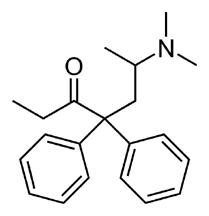Methadone
Methadone is a synthetic opioid that is most commonly used as a maintenance treatment for opioid addiction. Methadone, developed in Germany in 1937, although chemically unlike morphine or heroin, acts on the same opioid receptors as these drugs, and thus has many of the same effects. Methadone is also used in managing severe chronic pain, due to its long duration of action, high potency, and very low cost.
Methadone is very useful in the treatment of opioid dependence and addiction. It has similar effects to other opioids and a long duration of effect, meaning most patients in maintenance only need to be dosed once per day. Oral doses of methadone can stabilize patients by treating the symptoms of opioid withdrawal syndrome. Higher doses of methadone can block the euphoric effects of heroin, morphine, and similar drugs. As a result, properly dosed methadone patients can reduce or stop altogether their use of these substances.
Although there are strict regulations regarding how methadone can be distributed to patients for maintenance purposes, including supervised dosing, methadone can still be found on the street. Non-addicts and opiate-naive individuals may use methadone recreationally and experience different effects than someone taking a prescribed daily dose of methadone for maintenance purposes. For patients in a methadone maintenance program, methadone does not produce any euphoria, or 'high', while preventing any symptoms of opioid withdrawal.
Brand Names
Methadose, Dolophine, Symoron, Physeptone, Metadol
Street Names
done, dollies, meth, juice, drink, junk
Formulations
- Methadose - tablet, methadone hydrochloride (HCl): 5 mg, 10 mg, 40 mg
- Methadose - oral concentrate, methadone HCl: 10 mg/mL
- Dolophine - tablet, methadone HCl: 5 mg, 10 mg
- Metadol - tablet, methadone HCl: 1 mg, 5 mg, 10 mg, 25 mg
- Metadol - oral solution, methadone HCl: 1 mg/mL, 10 mg/mL
Medical Uses
- treatment of opioid dependence/addiction
- relief of moderate to severe pain
- occasionally used as treatment for violent cough
Route of Administration
oral, intravenous (IV), insufflation (snorting), sublingual, rectal
Half-life
15-60 h
Medical Dosage
- pain relief: 2.5 to 10 mg orally every 3-12 h; 2.5 to 10 mg injection (IV, IM, SC) every 3-6 h
- narcotic addiction maintenance: varies greatly between patients; majority require 80-125 mg/day oral or more.
- Clinics often start patients at a dose of around 30 mg/day and increased over time until a stable dose is reached.
Legality
- Methadone is a Schedule II drug in the United States.
- Methadone may be prescribed for pain in the U.S. as well as a treatment for drug addiction.
- Methadone used for detoxification can only be prescribed and administered by licensed clinics where patients are usually given methadone in liquid to be taken while watched by the dispensing nurse.
- Methadone is a Schedule II drug in Canada.
Images
References
- Lynch ME. A review of the use of methadone for the treatment of chronic noncancer pain. Pain Research and Management: The Journal of the Canadian Pain Society Autumn 2005; 10(3):133-44. [PubMed] [PDF]
- Joseph H, Stancliff S, Langrod J. Methadone maintenance treatment (MMT): a review of historical and clinical issues. Mount Sinai Journal of Medicine Oct-Nov 2000; 67(5-6):347-64. [PubMed] [PDF]
- Schumacher MA, Basbaum AI, Way WL, Opioid Analgesics & Antagonists (Chapter 31) in: Basic and Clinical Pharmacology. 12e. Katzung BG, Masters SB, Trevor AJ (Editors). McGraw-Hill / Lange, 2012.
- Clinical Practice Guideline for Management of Opioid Therapy for Chronic Pain. United States Department of Veterans Affairs / Department of Defense, May 2010. [PDF]
- Controlled Substances - Alphabetical Order. DEA Office of Diversion Control, May 2013. [PDF]
- Controlled Drugs and Substances Act. Minister of Justice, Canada, Nov 2012. [PDF]
Related Pages
-
Methadone Medication Identification
A list of imprints on methadone medicines with images and details including dosages, manufacturer, shape, and color. -
Methadone Maintenance
Methadone Maintenance Treatment (MMT) has been proven to be a safe and effective treatment for opioid dependence and addiction. Read about the history of methadone and how a methadone treatment program works. -
Methadone Side Effects
Although methadone is used to treat opioid addiction, it also comes with its own set of side effects that you should be aware of. Find out more about what to expect when using methadone, and the symptoms of an overdose. -
Buprenorphine
Buprenorphine is a semi-synthetic opioid analgesic used to treat opioid addiction as well as moderate acute and chronic pain. Available since the 1980s, it was only in 2002 that it was approved for maintenance treatment in opioid addicted individuals. -
Methadone Clinic Directory
A directory of methadone clinics in the U.S. and Canada. Each state and province has its own page with a list and map of methadone clinics in that state or province, as well as contact information for each clinic (address, phone number, website).
